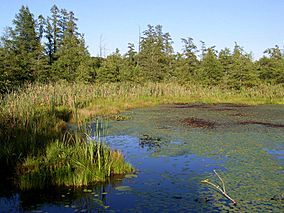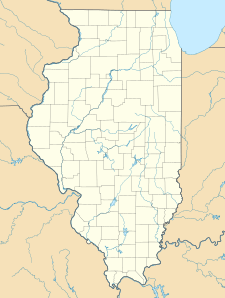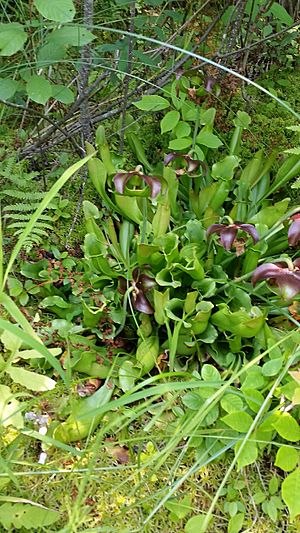Volo Bog State Natural Area facts for kids
Quick facts for kids Volo Bog State Natural Area |
|
|---|---|
|
IUCN Category V (Protected Landscape/Seascape)
|
|

The open-water center of Volo Bog, surrounded by tamarack trees
|
|
| Location | Lake County, Illinois, USA |
| Nearest city | Ingleside, Illinois |
| Area | 1,150 acres (470 ha) |
| Established | 1970 |
| Governing body | Illinois Department of Natural Resources |
| Designated: | 1972 |
Volo Bog State Natural Area is a special nature reserve in Illinois, USA. It protects a unique place called Volo Bog. This bog is super important because it's the only "quaking bog" in Illinois that still has open water. In 1973, it was named a National Natural Landmark.
Besides the bog, this natural area has many other cool habitats. You can find woodlands, savannas, marshes, and areas where prairies are being brought back to life. There are also shrublands and old fields. The Illinois Department of Natural Resources (Illinois DNR) takes care of the whole area. You can find it about a mile west of U.S. Route 12, between the towns of Volo and Fox Lake, Illinois.
Contents
What is Volo Bog?
The bog itself covers about 47.5 acres (19.2 ha). It started a long, long time ago, after the last Ice Age. A huge chunk of glacial ice melted and left behind a deep, steep-sided lake.
About 6,000 years ago, something amazing began to happen. A special kind of plant called sphagnum moss started growing out into the water. This moss played a huge part in changing the lake into the bog we see today.
How a Bog Forms
As the sphagnum moss mat grew thicker and older, the bog became very acidic. This change in the bog's pH levels was important. It allowed special plants that love acidic conditions to grow there.
These unique plants include leatherleaf, certain types of orchids, and tamarack trees. When tamarack trees started growing around the edge of the bog, it showed that the wetland was changing even more.
By the time people started exploring the area, Volo Bog was deep into a process called plant succession. This means plants were slowly changing the environment. The very center of the bog still had open water.
However, in shallower parts, the sphagnum moss cushion became thick enough for woody plants to grow. This included tamarack trees and even poison sumac. The edges of the bog were slowly becoming drier, changing from a bog into a different kind of wetland.
Different Habitats at Volo Bog
The protected area around the bog shows even more stages of plant succession. The entire state park is like a mini-lesson in how plant communities change over time. You can see everything from the bog itself, to wetlands, and then to sedge and grass meadows.
History of Volo Bog
In the 1800s, local people knew about Volo Bog, but not many outsiders did. The damp meadows around the bog were used for a dairy farm. However, the bog itself was not used for farming or business. The first scientific study mentioning Volo Bog was published in 1921 by W.G. Waterman.
As the 1900s continued, more and more people moved to the Chicago area. This growth put Volo Bog at risk from new housing developments. A person named Cyrus Mark led the effort to save the bog. He was the first president of the Illinois chapter of The Nature Conservancy.
Under Mark's leadership, the Conservancy's Illinois chapter bought the 47.5-acre (19.2 ha) bog. They then gave it to the University of Illinois in 1958. This was the very first piece of land the Illinois Nature Conservancy ever bought to protect! The university took care of the bog from 1958 until 1970.
In the 1960s, people became more aware of how important nature is. There were worries that the bog might not survive if it was just a small, isolated area. It became clear that the wetlands and meadows around the bog were essential for the bog itself to survive. These areas also helped teach people about plant succession.
So, in 1970, with lots of support from local people, the University of Illinois gave the bog to the Illinois Department of Natural Resources. The state of Illinois then started buying more land around the bog. This created the large 1,150-acre (470 ha) park we have today.
Volo Bog was officially listed as a National Natural Landmark in 1973. In 1980, one of the old dairy barns from the farm, built around 1900, was fixed up. It was reopened as the bog's visitor center.
Since 1980, a lot of work has been done at Volo Bog. They have rebuilt and kept up the trails throughout the bog. They have also made the bog and visitor center easier for people with disabilities to visit. Plus, they run ongoing nature education programs for both adults and schoolchildren.
Exploring Volo Bog
Volo Bog State Natural Area has two main trails for visitors to enjoy.
- Boardwalk Trail: An elevated 0.5-mile (0.80 km) boardwalk starts at the Visitor Center. It leads you right into the heart of the bog. This is a great way to see the unique plants up close without disturbing them.
- Ground Trail: A 2.75-mile (4.43 km) ground trail circles through the wetlands and meadows that surround the bog. This trail lets you explore the different habitats around the main bog area.




